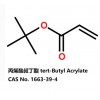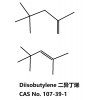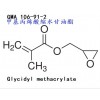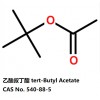Substance: TBA - tert-Butyl acrylate
Other name: Octa-(O-cyanoethyl)sucrose; 2,2,3,3,4,4,5,5-Octafluorohexanedioic Acid, Dimethyl Ester
1. Physical and chemical properties
Product name: tert-Butyl acrylate
CAS No.: 1663-39-4
Molecular Formula: C7H12O2
Molecular Weight: 128.17
Appearance form: colorless, clear,
liquid
Melting/freezing point: - 69 ℃
Boiling point: 121 ℃(1.013
bar)
Flash point: 17 ℃(closed
cup)
Density: 0.875 g/cm3(25 ℃)
UN No.: 1993
2. Parameters
index
Purity, (GC) ≥ 99.5%
Water Content ≤ 0.04 %
Acidity, (as Acrylic Acid) ≤ 0.1 %
Colour on despatch /(Pt-Co) ≤ 10
Standard Stabilization(MEHQ), 15±5 ppm
3. Package
information:
Big Barrel: 880kg per barrel
Small Barrel: 180kg per
barrel
Tank: 20 ton per tank
4. Applications
tert-Butyl acrylate forms
homopolymers and copolymers. Copolymers of tert-butyl acrylate can be
prepared with acrylic acid and its salts, amides and esters, and with
methacrylates, acrylonitrile, maleic acid esters, vinyl acetate, vinyl
chloride, vinylidene chloride, styrene, butadiene, unsaturated polyesters and
drying oils, etc. tert-Butyl acrylate is
also a very useful feedstock for chemical syntheses, because it readily
undergoes addition reactions with a wide variety of organic and inorganic
compounds.
5. Safety
A
Material Safety Data Sheet has been compiled for tert-butyl
acrylate that contains up-to-date information on all questions relevant to
safety.
6. Storage and
handling
In order to prevent
polymerization, tertiary butyl acrylate must always be stored under air, and
never under inert gases. The presence of oxygen is required for the stabilizer
to function effectively. It has to contain a stabilizer and the storage temperature
must not exceed 35 ℃。Under
these conditions, a storage stability of one year can be expected. In order to
minimize the likelihood of over storage, the storage procedure should strictly
follow the “first-in-first-out” principle. Storage tanks and pipes should be
made of stainless steel or aluminum. Although tertiary butyl acrylate does not
corrode carbon steel, there is a risk of contamination if corrosion does occur.
Regulations for the storage of flammable liquids must be observed
(explosion-proof electrical equipment, vented tanks with flame arresters etc.).
Storage tanks, pumps and pipes must be earthed.
7.
Note
The
data contained in this publication are based on our current knowledge and
experience. In view of the many factors that may affect processing and
application of our product, these data do not relieve processors from carrying
out their own investigations and tests; neither do these data imply any
guarantee of certain properties, nor the suitability of the product for a
specific purpose. Any descriptions, drawings, photographs, data, proportions,
weights etc. given herein may change without prior information and do not
constitute the agreed contractual quality of the product. It is the
responsibility of the recipient of our products to ensure that any proprietary
rights and existing laws and
legislation are observed.












